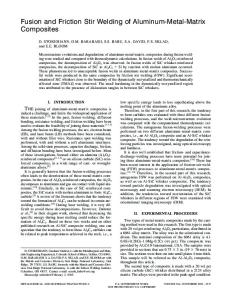A Phenomenological Model for Tool Wear in Friction Stir Welding of Metal Matrix Composites
- PDF / 579,764 Bytes
- 8 Pages / 593.972 x 792 pts Page_size
- 11 Downloads / 343 Views
INTRODUCTION
THE objective of the current article is to develop an analytic model for wear of the tool in friction stir welding (FSW) of metal matrix composites (MMCs). FSW is a relatively nascent solid-state joining process developed at The Welding Institute (TWI) of Cambridge, UK.[1] In FSW, the weld is performed by a tool composed of a shoulder and smaller-diameter pin. The shoulder serves as the primary source of heat generation and prevents expulsion of material from the joint. The pin penetrates the workpiece, plastically stirring the material in its vicinity. The tool simultaneously rotates and traverses along the weld seam. For an optimized process, FSW can produce a welded region with properties superior to fusion welds. FSW finds wide-ranging applications in the aerospace industry, where it is used to join lightweight aluminum alloys. In aluminum, the life of a FSW tool at optimized parameters is several thousands of feet—the tool does not wear appreciably, and besides an optional etch in NaOH or KOH to remove excess aluminum which sticks to the tool surface during welding, the tool requires no refurbishment between passes. A current focus of research is to expand FSW to advanced alloys that are difficult to weld using fusion methods. One such material is metal matrix composites (MMCs), which consist of ceramic particles or fibers (SiC or Al2O3) embedded in a metal matrix. These inclusions can drastically improve the mechanical properties of the base alloy with only a marginal increase in weight. TRACIE J. PRATER, BRIAN T. GIBSON, and CHASE D. COX, Graduate Student Researchers, ALVIN M. STRAUSS, Professor of Mechanical Engineering, and GEORGE E. COOK, Associate Dean for Research and Graduate Studies, are with the Vanderbilt University, Nashville, TN. Contact e-mail: [email protected] Manuscript submitted September 4, 2012. Article published online April 3, 2013 METALLURGICAL AND MATERIALS TRANSACTIONS A
Difficulties, however, arise when welding these materials to themselves or to one another as a consequence of the theta phase formed when molten aluminum reacts with reinforcement particles or fibers.[2] Theta phase (Al4C3 in the case of SiC-reinforced composites) is not observed in FS-welded MMC joints since the process occurs below the melting temperature.[2] The major obstacle to joining MMCs using FSW is wear of the tool, as the particles used as reinforcement in MMCs are typically much harder than the materials conventionally used for FSW tooling. Tool wear is undesirable because it can lead to the formation of root flaw defects which accompany shortening of the pin or the erosion of features which promote stirring. Figure 1 shows an overlay of close-up images of the tool probe taken after successive welds of Al 359/SiC/20p.[3] While wear appears to be axially symmetric, the amount of volume lost by the tool varies substantially with location along the length of the probe. The greatest material loss is observed in the region at the probe tip, while little if any material is eroded in the vicinity of
Data Loading...











